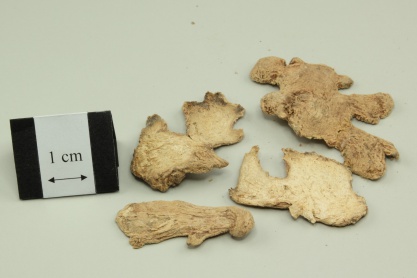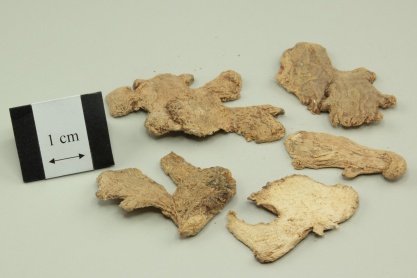乾薑
- ENG
- Zingiber (Dried Ginger)
- LATIN
- Zingiberis Rhizoma
| Medicinal Group | Interior-warming medicinal |
|---|---|
| Source | Dried rhizome of Zingiber officinale (Willd.) Rosc. (Fam. Zingiberaceae) |
| Nature and Flavors | pungent; hot |
| Meridian Affinity | Heart, Lung, Kidney, Stomach |
| Actions | To warm the middle and dissipate cold, promote recovery from collapse, and eliminate damp and resolve phlegm |
Family
Zingiberaceae
Part used
Root and Rhizome
Indications
Epigastric pain with cold feeling, vomiting and diarrhea accompanied with cold extremities and faint pulse; dyspnea and cough with copious frothy expectoration
Research Findings
- 3 months supplementation of ginger improved glycemic indices and total antioxidant capacity in patients with type 2 diabetes. [1]
- Ginger supplementation could improve insulin sensitivity and some fractions of lipid profile in type 2 diabetic patients.[2]
- Treatment of primary dysmenorrhea in students with ginger for 5 days had a statistically significant effect on relieving intensity and duration of pain.[3]
- Ginger powder has add-on effect on reducing the symptoms of osteoarthritis of knee with acceptable safety profile.[4]
- Ginger supplementation at a daily dose of 0.5 g-1.0 g significantly aids in reduction of the severity of acute chemotherapy-induced nausea in adult cancer patients.[5]
- Ginger can be considered as a useful treatment option for women suffering from morning sickness.[6]
Cautions
No Data.
Report on adverse effect
Contact dermatitis of the finger tips has been reported in sensitive patients [7]
Reference
Reference
- Shidfar F, Rajab A, Rahideh T, Khandouzi N, Hosseini S, Shidfar S. ( 2015). The effect of ginger (Zingiber officinale) on glycemic markers in patients with type 2 diabetes. J Complement Integr Med. , 12(2):165-70. doi: 10.1515/jcim-2014-0021.
- Mahluji S, Attari VE, Mobasseri M, Payahoo L, Ostadrahimi A, Golzari SE. (2013). Effects of ginger (Zingiber officinale) on plasma glucose level, HbA1c and insulin sensitivity in type 2 diabetic patients. Int J Food Sci Nutr. , 64(6):682-6. doi: 10.3109/09637486.2013.775223. Epub 2013 Mar 18.
- Rahnama P, Montazeri A, Huseini HF, Kianbakht S, Naseri M. ( 2012 ). Effect of Zingiber officinale R. rhizomes (ginger) on pain relief in primary dysmenorrhea: a placebo randomized trial. BMC Complement Altern Med. , 12:92. doi: 10.1186/1472-6882-12-92.
- Paramdeep G. (2013). Efficacy and tolerability of ginger (Zingiber officinale) in patients of osteoarthritis of knee. Indian J Physiol Pharmacol. , 57(2):177-83.
- Ryan JL, Heckler CE, Roscoe JA, Dakhil SR, Kirshner J, Flynn PJ, Hickok JT, Morrow GR. (2012). Ginger (Zingiber officinale) reduces acute chemotherapy-induced nausea: a URCC CCOP study of 576 patients. Support Care Cancer. , 20(7):1479-89. doi: 10.1007/s00520-011-1236-3. Epub 2011 Aug 5.
- Willetts KE, Ekangaki A, Eden JA. (2003). Effect of a ginger extract on pregnancy-induced nausea: a randomised controlled trial. Aust N Z J Obstet Gynaecol. , 43(2):139-44.
- Seetharam KA, Pasricha JS. Condiments and contact dermatitis of the finger tips. Indian journal of dermatology, venereology and leprology, 1987, 53:325–328.












